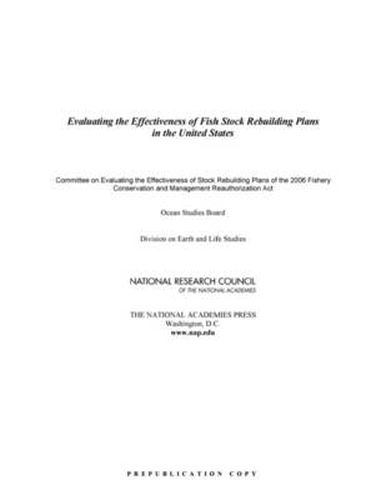Evaluating the Effectiveness of Fish Stock Rebuilding Plans in the United States
National Research Council,Division on Earth and Life Studies,Ocean Studies Board,Committee on Evaluating the Effectiveness of Stock Rebuilding Plans of the 2006 Fishery Conservation and Management Reauthorization Act

Evaluating the Effectiveness of Fish Stock Rebuilding Plans in the United States
National Research Council,Division on Earth and Life Studies,Ocean Studies Board,Committee on Evaluating the Effectiveness of Stock Rebuilding Plans of the 2006 Fishery Conservation and Management Reauthorization Act
In the United States (U.S.), the Fishery Conservation and Management Act of 1976, now known as the Magnuson-Stevens Fishery Conservation and Management Act (MSFCMA), was the first major legislation to regulate federal fisheries in the U.S. Fishery Conservation Zone (later designated as the U.S. exclusive economic zone). The re-authorization of the MSFCMA passed by Congress in 2006 included additional mandates for conserving and rebuilding fish stocks and strengthening the role of scientific advice in fisheries management. Approximately 20% of the fisheries that have been assessed are considered overfished according to the September 2012 stock status Report to Congress prepared by the U.S. National Oceanic and Atmospheric Administration (NOAA). Overfished refers to a stock that is below the minimum stock size threshold, commonly set to half the stock size at which maximum sustainable yield (MSY) is achieved. Under the provisions of the MSFCMA, rebuilding plans for overfished stocks should take no more than 10 years, except when certain provisions apply. Rebuilding mandates have led to substantial reductions in catch and effort for many fisheries, raising concerns about the consequent social and economic impacts to the fishing communities and industry.
Evaluating the Effectiveness of Fish Stock Rebuilding Plans in the United States reviews the technical specifications that underlie current federally-implemented rebuilding plans, and the outcomes of those plans. According to this report, fisheries management has evolved substantially since 1977 when the U.S. extended its jurisdiction to 8 200 miles, in the direction of being more prescriptive and precautionary in terms of preventing overfishing and rebuilding overfished fisheries. However, the trade-offs between precaution and yield have not been fully evaluated. Evaluating the Effectiveness of Fish Stock Rebuilding Plans in the United States discusses the methods and criteria used to set target fishing mortality and biomass levels for rebuilding overfished stocks, and to determine the probability that a particular stock will rebuild by a certain date. This report will be of interest to the fishing industry, ecology professionals, and members of Congress as they debate the renewal of the Magnuson-Stevens Fishery Conservation and Management Act.
This item is not currently in-stock. It can be ordered online and is expected to ship in approx 4 weeks
Our stock data is updated periodically, and availability may change throughout the day for in-demand items. Please call the relevant shop for the most current stock information. Prices are subject to change without notice.
Sign in or become a Readings Member to add this title to a wishlist.


